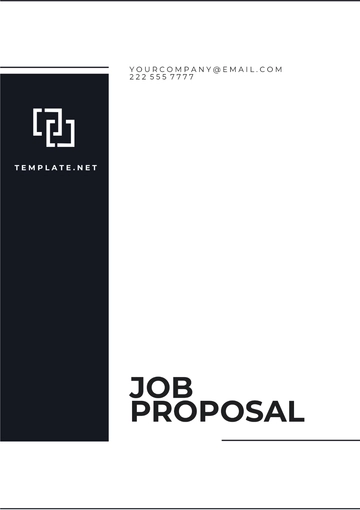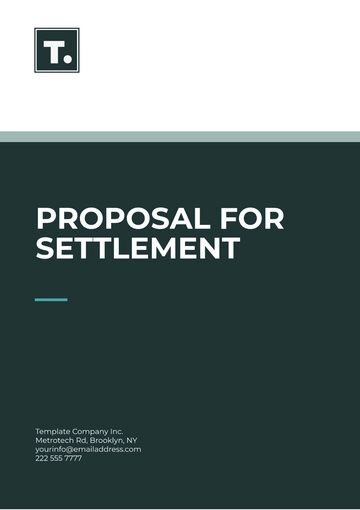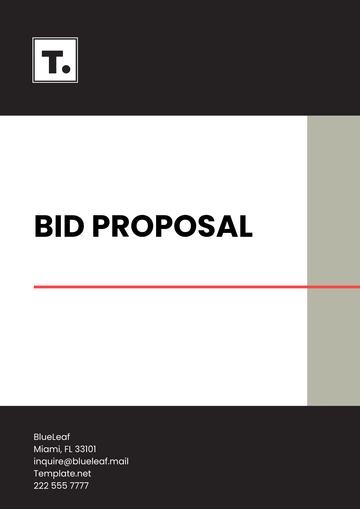Free Health & Safety Campaign Proposal

Introduction
This proposal outlines a comprehensive Health & Safety Campaign designed to enhance understanding, encourage proactive practices, and ultimately cultivate a safer work environment.
Objectives
To elevate the awareness and understanding of health and safety protocols among all employees.
To instill a culture of proactive health and safety practices in every aspect of our workplace.
To significantly reduce the incidence of workplace injuries and illnesses, creating a safer and more productive work environment.
The significance of this campaign extends beyond compliance with health and safety regulations. It's about creating an environment where safety is ingrained in every action and decision, ensuring that every employee feels valued, protected, and empowered to contribute to a safer workplace.
Campaign Theme and Branding
Campaign Name
"[Safety First: Every Day, Every Way]"
Branding Elements
The visual identity of the campaign is designed to be impactful and convey the safety message effectively.
Logo: A stylized shield with a checkmark symbolizing protection and affirmative safety practices, encircled to represent ongoing commitment to safety.
Color Scheme: Primary colors are bright red and yellow for high visibility, caution, and alertness, complemented by white and black for contrast and readability
Slogan and Messaging
Slogan: "Your Safety, Our Priority"
Messaging: Focuses on personal responsibility and collective benefits of a safe workplace, using clear, action-oriented language to promote proactive safety behaviors.
Promotional Materials
A range of materials including posters, brochures, and digital banners, all incorporating the campaign’s branding elements.
Merchandise such as safety vests, helmets, and water bottles will also feature the campaign's logo and color scheme.
Target Audience Analysis
Demographics
Our approach is inclusive, targeting the entire workforce but with tailored messages for specific groups.
Demographic Group | Description | Specific Focus |
Age Group: 20-30 | Younger, newer employees | Basic safety training, addressing risk-taking behavior |
Age Group: 31-45 | Mid-career, many in supervisory roles | Advanced safety protocols, leadership in safety |
Age Group: 46-60 | Senior employees, experienced | Safety mentorship, long-term health practices |
Psychographics
Understanding diverse attitudes and behaviors towards safety is crucial.
Attitudes towards safety: Ranging from proactive to passive, the campaign aims to elevate everyone to a high level of safety awareness.
Learning Preferences: Catering to a mix of visual, hands-on, and written learning styles.
Departmental Analysis
Addressing unique risks and training needs of different departments.
Department | Primary Risks | Training Focus |
Manufacturing | Machinery accidents, noise | Machinery safety, hearing protection |
Office Staff | Ergonomic injuries, eye strain | Ergonomic practices, regular breaks |
Field Services | Environmental hazards, travel | Environmental awareness, travel safety |
Communication Channels
Effective communication is the backbone of our campaign. We will leverage a variety of channels to ensure our message reaches every employee in the most impactful way.
Internal Channels
Email Newsletters: Bi-weekly newsletters featuring safety tips, updates on health and safety policies, and spotlight stories of employees exemplifying excellent safety practices.
Intranet Postings: A dedicated section for health and safety, including interactive content like quizzes and infographics.
Physical Bulletin Boards: Strategically placed in common areas like break rooms, displaying safety reminders, and updates.
External Channels
Company's Social Media Pages: Regular posts on safety tips, campaign activities, and achievements in safety, targeting a broader audience including families of employees.
Press Releases: Announcements of significant campaign milestones or events, such as the launch of a new safety initiative, shared with local media outlets.
Engagement Metrics
Channel | Metric | Goal |
Email Newsletters | Open and Click Rates | [75% open rate, 30% click rate] |
Intranet Postings | Engagement (likes, shares, comments) | [High engagement on each post] |
Bulletin Boards | Employee Feedback | [Positive feedback in employee surveys] |
Training Programs
Our training programs are designed to be comprehensive, engaging, and cater to the diverse needs of our workforce.
Orientation Sessions
For New Employees: An introductory session on their first day, covering basic health and safety protocols, emergency procedures, and company-specific safety policies.
Regular Training Workshops
Workshop Topics: A diverse range of topics including First Aid, Fire Safety, Ergonomics, Hazardous Material Handling, and Stress Management.
Frequency: Quarterly, with different topics each quarter to ensure comprehensive coverage over the year.
Format: A mix of in-person and virtual sessions, accommodating different schedules and learning preferences.
Specialized Departmental Training
Customized Training: Tailored sessions for specific departments, addressing the unique risks and safety procedures relevant to their work environment.
Collaboration with External Experts: Engaging industry experts for specialized training sessions, ensuring up-to-date and authoritative information.
Training Metrics
Training Type | Metric | Goal |
Orientation Sessions | Completion Rate | [100% completion by new employees] |
Regular Workshops | Attendance Rate | [85% attendance across departments] |
Specialized Training | Employee Skill Assessment | [90% pass rate in post-training assessments] |
Campaign Activities
Engaging activities are crucial for reinforcing the safety message and encouraging active participation from all employees. Our campaign will feature a variety of initiatives designed to be both informative and interactive.
Health and Safety Week
Launch Event: A kick-off event featuring keynote speakers on safety, interactive booths, and demonstrations of safety equipment.
Workshops and Seminars: Daily sessions on topics like workplace ergonomics, mental health, and emergency response.
Interactive Sessions: Activities such as safety drills, first aid competitions, and ergonomic assessments.
Monthly Safety Challenges
Safety Scavenger Hunt: A monthly activity where employees find and report potential safety hazards in return for rewards.
Wellness Challenges: Encouraging healthy lifestyle choices that contribute to overall safety, like hydration challenges or step contests.
Recognition and Rewards
Safety Star of the Month: Recognizing an employee each month who exemplifies outstanding safety practices.
Team Safety Awards: Quarterly awards to departments that achieve the best safety records or show significant improvements.
Campaign Events Calendar
Month | Activity | Objective |
[Date] | Health and Safety Week | Kick-off campaign, raise awareness |
[Date] | Ergonomics Assessment Challenge | Promote healthy workstation setups |
[Date] | Fire Safety Drill | Reinforce emergency response skills |
[Date] | Year-End Safety Review & Celebration | Recap achievements, celebrate progress |
Monitoring and Evaluation
To measure the effectiveness of our campaign and ensure continuous improvement, a robust monitoring and evaluation plan is essential.
Key Performance Indicators (KPIs)
Reduction in Workplace Accidents: Track the decrease in the number and severity of accidents.
Employee Participation Rate: Measure the percentage of employees participating in training programs and activities.
Feedback Mechanisms
Surveys Post-Training Sessions: Gather feedback on the effectiveness and relevance of training content.
Suggestion Boxes: Placed in common areas for employees to provide anonymous feedback and suggestions.
Continuous Improvement Plan
Quarterly Reviews: Assess the progress of the campaign and make adjustments based on KPIs and feedback.
Annual Report: Compile an end-of-year report detailing achievements, lessons learned, and goals for the next year.
Evaluation Table
Criteria | Measurement Tool | Frequency | Target |
Accident Reduction | Safety Incident Reports | Monthly | [20% reduction year-over-year] |
Training Effectiveness | Post-Training Surveys | After each session | [85% positive feedback] |
Employee Engagement | Participation Records | Per activity | [75% workforce involvement] |
Budget and Resources
A well-planned budget and efficient resource allocation are key to the successful implementation of the Health & Safety Communication & Awareness Campaign. The following is a detailed breakdown of the anticipated budget and resource needs.
Estimated Budget
The budget is categorized into various components essential for the campaign:
Item | Estimated Cost | Description |
Training Materials | [$5,000] | Includes handouts, first-aid kits, and ergonomic tools |
Campaign Materials | [$3,000] | Production of posters, brochures, digital content |
External Communications | [$2,000] | Costs for social media promotion, press releases |
Event Expenses | [$4,000] | Venue, guest speakers, interactive booths |
Employee Recognition and Rewards | [$1,500] | Monthly and quarterly safety awards |
Miscellaneous | [$500] | Contingency funds for unforeseen expenses |
Total Estimated Budget: [$16,000]
Resource Allocation
Human Resources: Assignment of roles within the Health & Safety team for campaign management, training facilitation, and event organization.
Material Resources: Procurement and distribution of training materials, campaign promotional items, and safety equipment.
Technology Resources: Development and maintenance of digital platforms for campaign communication, including the intranet and email newsletters.
Timeline and Milestones
Date | Milestone | Objective |
[Date] | Campaign Launch | Official start of the campaign |
[Date] | Health & Safety Week | Engage employees in various safety activities |
[Date] | First Monthly Safety Challenge | Encourage ongoing safety awareness |
[Date] | Q1 Review and Feedback Collection | Assess progress and gather employee feedback |
[Date] | Mid-Campaign Review and Strategy Update | Adjust campaign based on mid-year insights |
[Date] | Planning for Year 2 | Start preparations for the following year |
[Date] | Year-End Review and Celebration | Recap achievements, acknowledge contributions |
Risk Management
Effective risk management is crucial to ensure the success of the Health & Safety Communication & Awareness Campaign. Identifying potential risks and developing strategies to mitigate them will help in maintaining the integrity and effectiveness of the campaign.
Potential Risks
Understanding and planning for potential risks will allow us to preemptively address challenges that may arise during the campaign.
Low Employee Engagement: There's a risk that employees might not actively participate in the campaign activities or training sessions.
Budget Constraints: Financial limitations could affect the scope or quality of campaign activities and materials.
Inadequate Resource Allocation: Mismanagement or underestimation of resources needed for various campaign elements.
Changing Regulations: Health and safety regulations can evolve, potentially making some campaign content outdated.
Miscommunication: Risk of misinterpreting or poorly communicating safety messages, leading to confusion or non-compliance.
Mitigation Strategies
For each identified risk, specific strategies are developed to minimize their impact.
Risk | Mitigation Strategy |
Low Employee Engagement | Implement engaging and interactive content, regular feedback mechanisms, and incentives for participation. |
Budget Constraints | Regular budget reviews, seeking sponsorships or partnerships, and optimizing resource usage. |
Inadequate Resource Allocation | Detailed planning, regular monitoring of resource usage, and contingency plans for unexpected needs. |
Changing Regulations | Stay updated with regulatory changes, and have a plan to quickly update campaign materials and training content. |
Miscommunication | Clear and consistent messaging across all channels, training for communicators, and regular message reviews. |
Continuous Risk Monitoring
Regular Assessments: Conducting periodic assessments of the risk management plan to ensure its relevance and effectiveness.
Feedback Loop: Establishing a robust feedback system to gather insights from employees on potential risks or issues faced during the campaign.
Crisis Management Plan
Emergency Response Team: A dedicated team to address any crises that may arise, equipped with the necessary resources and authority.
Communication Strategy: A clear plan for internal and external communication in case of a crisis, ensuring transparency and swift information dissemination.
Conclusion
The Health & Safety Campaign is more than just a series of activities and messages; it's a strategic initiative aimed at fundamentally transforming our workplace culture. By meticulously planning and executing this campaign, we anticipate creating an environment where safety is not just a policy but a core value. Through this campaign, we expect to see a measurable improvement in safety practices, a reduction in incidents, and an overall enhancement in the health and wellbeing of our workforce. The long-term impact will be a more informed, alert, and conscientious workforce that takes collective responsibility for safety.
- 100% Customizable, free editor
- Access 1 Million+ Templates, photo’s & graphics
- Download or share as a template
- Click and replace photos, graphics, text, backgrounds
- Resize, crop, AI write & more
- Access advanced editor
Introducing Template.net's Health & Safety Campaign Proposal Template. This editable and customizable template offers a comprehensive framework for outlining strategies to promote workplace health and safety. Utilize our AI Editor Tool to tailor the proposal to your organization's needs, ensuring effective communication and the implementation of safety initiatives.
You may also like
- Business Proposal
- Research Proposal
- Proposal Request
- Project Proposal
- Grant Proposal
- Photography Proposal
- Job Proposal
- Budget Proposal
- Marketing Proposal
- Branding Proposal
- Advertising Proposal
- Sales Proposal
- Startup Proposal
- Event Proposal
- Creative Proposal
- Restaurant Proposal
- Blank Proposal
- One Page Proposal
- Proposal Report
- IT Proposal
- Non Profit Proposal
- Training Proposal
- Construction Proposal
- School Proposal
- Cleaning Proposal
- Contract Proposal
- HR Proposal
- Travel Agency Proposal
- Small Business Proposal
- Investment Proposal
- Bid Proposal
- Retail Business Proposal
- Sponsorship Proposal
- Academic Proposal
- Partnership Proposal
- Work Proposal
- Agency Proposal
- University Proposal
- Accounting Proposal
- Real Estate Proposal
- Hotel Proposal
- Product Proposal
- Advertising Agency Proposal
- Development Proposal
- Loan Proposal
- Website Proposal
- Nursing Home Proposal
- Financial Proposal
- Salon Proposal
- Freelancer Proposal
- Funding Proposal
- Work from Home Proposal
- Company Proposal
- Consulting Proposal
- Educational Proposal
- Construction Bid Proposal
- Interior Design Proposal
- New Product Proposal
- Sports Proposal
- Corporate Proposal
- Food Proposal
- Property Proposal
- Maintenance Proposal
- Purchase Proposal
- Rental Proposal
- Recruitment Proposal
- Social Media Proposal
- Travel Proposal
- Trip Proposal
- Software Proposal
- Conference Proposal
- Graphic Design Proposal
- Law Firm Proposal
- Medical Proposal
- Music Proposal
- Pricing Proposal
- SEO Proposal
- Strategy Proposal
- Technical Proposal
- Coaching Proposal
- Ecommerce Proposal
- Fundraising Proposal
- Landscaping Proposal
- Charity Proposal
- Contractor Proposal
- Exhibition Proposal
- Art Proposal
- Mobile Proposal
- Equipment Proposal
- Student Proposal
- Engineering Proposal
- Business Proposal





























